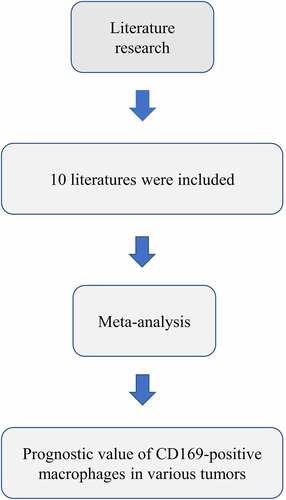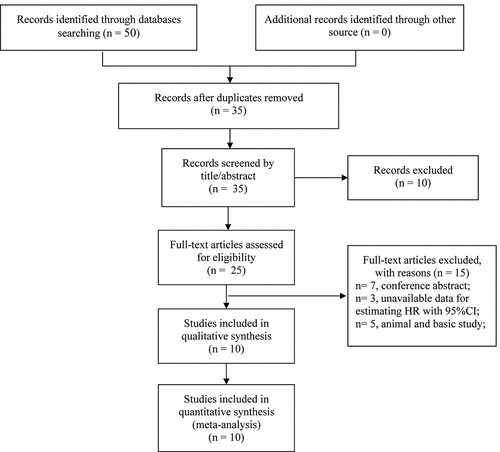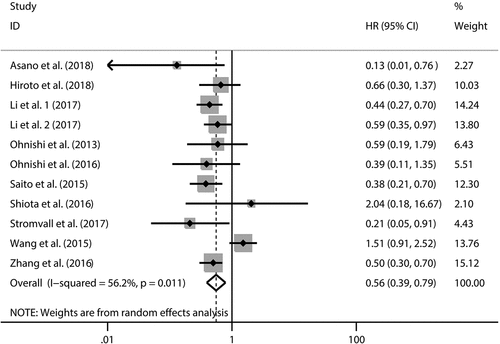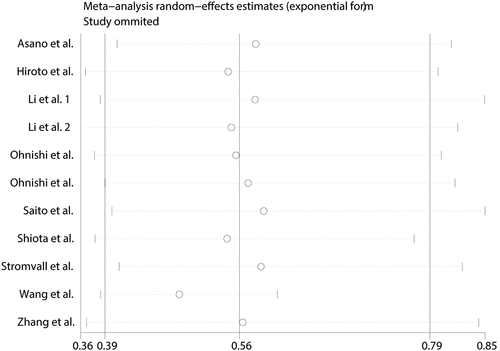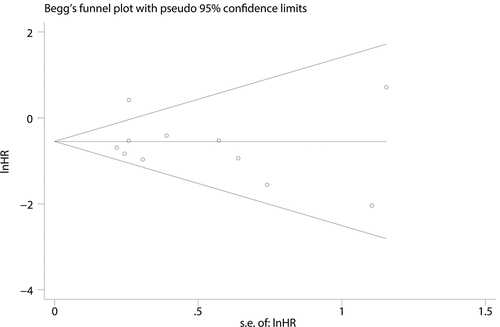ABSTRACT
The study aimed to evaluate the prognostic value of CD169 expression in tumor-infiltrating macrophages from regional lymph nodes (RLN) in various tumors. In order to identify eligible articles, PubMed, EMBASE, Web of Science, and Cochrane Library were used to conduct a systematic search. Pooled hazard ratios (HRs) or odds ratios (ORs) with corresponding 95% confidence intervals (CIs) were adopted to assess the relationship between CD169 expression and overall survival (OS) and clinicopathological characteristics. Ten studies, including eleven cohorts with 1699 patients, were enrolled. We found that high CD169+ expression in tumor-infiltrating macrophages from RLN was associated with a favorable OS (HR = 0.56, 95%CI: 0.39–0.79, P = 0.001). Subgroup analysis showed that high CD169+ expression had more predictive power in digestive system tumors (HR = 0.52, 95%CI: 0.42–0.67, <0.001). In addition, high CD169 expression was significantly linked with lymph node metastasis (OR = 0.66, 95%CI: 0.47–0.94, P = 0.020) and TNM stage (OR = 0.62, 95%CI: 0.48–0.80, P < 0.001). High CD169 expression in tumor-infiltrating macrophages from RLN was correlated with favorable survival outcome in patients with malignancies. CD169 may be a novel and effective prognostic marker, especially for digestive system tumors.
KEYWORDS:
Introduction
The incidence and mortality of cancer is rapidly growing because of the aging and growth of the population as well as socio-economic development [Citation1,Citation2]. According to the statistics, 18.1 million newly diagnosed cancer cases and 9.6 million cancer-related deaths occurred in 2018 [Citation1]. Despite advanced drug treatments and surgical methods, the therapeutic response differs significantly in patients, and the overall prognosis of most cancers is still not very satisfactory [Citation3]. The complex molecular mechanisms are the features of cancer cells. Therefore, it is imperative for us to explore applicable predictive biomarkers so that we enable to accurately evaluate accurately the therapeutic effect and prognosis of patients with malignancies.
Macrophages, an indispensable component of the innate immune system, are spread across the body [Citation4]. Plenty of tumor-associated macrophages are detected in tumors, and them contribute to the major inflammatory infiltrate in various malignancies [Citation5,Citation6]. Macrophages have both pro- and anti-tumorigenic functions in different local tumor environmental conditions. The regional lymph nodes(RLN) is one of the first major components of the immune system that comes into contact with tumor cells or tumor cell products, and plays an important role in generating tumor-directed immune responses [Citation7]. The macrophages located in RLN also play an important role in tumor immunology through endocytosing the fragmented dead tumor cells of the sinus area of the lymph nodes [Citation7–10]. These findings suggest that regional lymph nodes or tumor-infiltrating macrophages represent a pivotal component in various tumor immunology.
CD169 (also known as Siglec-1) is a surface marker of macrophages and belongs to the sialic-acid-binding immunoglobulin-like lectin family, which can mediate cell-cell interactions via glycan recognition [Citation11,Citation12]. Nowadays, researchers recommended that CD169 expression in tumor-infiltrating macrophage from RLN served as a promising prognostic marker of multiple cancers [Citation13–19]. However, their conclusions were contradictory. The prognostic value of CD169 expression in tumor-infiltrating macrophages from RLN was still unclear. Therefore, we conducted this meta-analysis to clarify the prognostic power of CD169 in cancers.
Materials and methods
Search strategy
A systematic search for eligible articles was conducted through PubMed, Web of Science, EMBASE, and Cochrane Library database. The search deadline was up to December 2020. The following keywords were used: ‘CD169’ OR ‘sialoadhesin’ OR ‘Siglec-1’ AND ‘cancer’ OR ‘carcinoma’ OR ‘neoplasm’ OR ‘tumor’ AND ‘prognosis’ OR ‘prognostic’ OR ‘survival’ OR ‘outcome’ AND ‘Macrophage’. Additionally, the reference lists of the included studies were explored for potentially relevant articles.
Study selection
The searching tasks were carried out independently by three authors (Kong WH, Wei and Liu RQ). Selection criteria employed in this meta-analysis to incorporate eligible studies were as follows: 1) Original English publication, 2) investigated the association between CD169 and single or multiple malignancies, 3) focusing on the CD169 and clinical outcomes.
Data extraction and quality assessment
Data extraction was performed by three reviewers (Kong WH, Wei M and Liu RQ) independently. The fourth reviewer (Zhang JL) would be involved in the discussion when any discrepancies were met. Extracted data and information included as follows: 1) The first author and the year of publication, 2) Article nationality, 3) Type of cancer, 4) The case number of included studies, 5) Median age of patients, 6) Test method of CD169 expression, 7) Definition of high or low CD169+ macrophages, 8) Location of the specimen, 9) Survival results, 10) Follow-up months. The quality of each included study was evaluated using the Newcastle-Ottawa scale (NOSs) [Citation20,Citation21]. NOS score from 0–4 was defined as low quality, 5–6 as medium quality, and 7–9 as high quality.
Statistical analysis
The pooled hazard ratios (HRs)or odds ratios (ORs) with the 95% confidence intervals (CIs) were calculated to illustrate the relationship between CD169 expression and survival outcome and clinicopathological characteristics. Cochran’s Q test and I2 statistics were performed to evaluate heterogeneity [Citation22,Citation23]. Heterogeneity was perceived as significant when I2 > 50% or p < 0.1, which determined the adoption of random effect models. Otherwise, fixed effect models were chosen. Moreover, the stability of the merged result was assessed by sensitivity analysis. Begg’s and Egger’s tests were utilized to detect the publication bias [Citation24]. STATA 12.0 (StataCorp, College Station, TX, USA) was employed to conduct statistical analyses. P less than 0.05 was considered as statistical difference.
Results
Brief introduction
CD169 macrophages have been reported to play a pivotal role in anti-tumor immunity, but its prognostic value remains controversy. Therefore, a meta-analysis evaluating the prognostic value value of CD169 expression in tumor-infiltrating macrophages from regional lymph nodes was conducted. We retrieved articles about the relationship between CD169 expression and prognostic value in multiple tumors from the database. Through meta-analysis, we found that the high CD169 expression was significantly related to favorable prognosis, lymph node metastasis, and TNM stage.
Literature search and study characteristics
Literature selection flow was shown in in accordance with the PRISMA statement [Citation25]. A total of 50 studies were initially identified through the search strategy described above. However, 15 studies were removed for duplication, and 25 studies were excluded based on the titles, abstracts, and full texts. Eventually, ten studies with 1699 patients were incorporated in the present meta-analysis. . summarizes the baselines characteristics of selected ten studies. The malignant neoplasm contained bladder cancer, esophageal cancer, hepatocellular carcinoma, gastric cancer, colorectal carcinoma, endometrial carcinoma, melanoma, breast cancer, prostate cancer, and bladder urothelial carcinoma. Surgically resected tissues were collected to detect the CD169 expression in all studies. As for survival results, overall survival (OS) was reported in nine studies; one research displayed the OS and relapse-free survival (RFS). All the included studies were retrospective. Follow-up time among studies varied from 82 months to 250 months in ten studies. The quality assessment of the included studies was presented in .
Table 1. Baseline characteristics of studies included in the meta-analysis
Table 2. Newcastle -Ottawa Quality Assessment Scale
Association between CD169 expression and OS
Ten studies reported the association between CD169 expression and OS. we found a significant relationship between high CD169 expression and longer OS in cancers (HR: 0.56, 95%CI: 0.39–0.79, P = 0.001) (). Additionally, the heterogeneity among the studies (I2 = 56.2%, P = 0.011) was significant. To explore the source of heterogeneity, subgroup analysis for OS was performed (). The results were displayed in . We found that the sources of heterogeneity included country, tumor type, sample size, definition of high or low, macrophages location, analysis type and NOS score. In addition, we also observed that high CD169+ expression had more predictive power in digestive system tumors (HR = 0.52, 95%CI: 0.42–0.67, <0.001).
Table 3. Subgroup analysis for overall survival
Association between CD169 expression and clinicalpathological parameters
We summarized the data to assess the relationship between CD169 expression and clinicopathological characteristics (). The combined results indicated that high CD169 expression was obviously related with TNM stage (III–IV vs I–II) (OR = 0.62, 95% CI: 0.48, 0.80, P < 0.001) and Lymph node metastasis (yes vs no)(OR = 0.66, 95% CI: 0.47–0.94; P = 0.020). However, the correlation was not observed in vascular invasion and histological grade. We believed that high CD169 expression may play an important role in preventing tumor invasion and lymph node metastasis
Table 4. Association between CD169+ macrophages and clinicopathological features
Sensitivity analysis
Sensitivity analysis was employed to assess the influence of each individual study on the pooled HR. The results did not vary substantially with the exclusion of each research, which demonstrated stability and reliability of our results ().
Publication bias
The publication bias was detected by Begg’s tests and Egger’s tests. P-values for the Begg’s and Egger’s tests for OS were 0.876 and 0.587, respectively. P values were greater than 0.05, indicating no publication bias ().
Discussion
Macrophages, which are consisted of diverse subpopulations based on specific markers, have diverse functions, including both pro-tumor and anti-tumor functions [Citation26,Citation27]. Macrophages in various cancers differ in distribution and composition patterns. Sinus macrophages play a pivotal role in anti-tumor immunity by endocytosing dead tumor cells, presenting antigens, and activating tumor antigen-specific lymphocytes [Citation10,Citation28]. CD169, which is a sialic acid receptor expressed on macrophages, is involved in the process of cell-cell interactions and cell-pathogen interactions. Increasing evidences have suggested that CD169+ macrophages play a crucial role in the anti-tumor immune response [Citation28,Citation29].
In the present study, a significant relationship was revealed between the high CD169 expression and OS (HR: 0.56, 95%CI: 0.39–0.79, P = 0.001). Subgroup analysis showed that the abundance of CD169 macrophages had a significant relationship with OS in Japan (HR: 0.48, 95%CI: 0.32–0.71, P < 0.001) and Sweden (HR: 0.21, 95%CI: 0.05–0.90, P = 0.035). We speculated that this may be caused by differences in genes, geography and climate. Moreover, high CD169+ expression had more predictive power in digestive system tumors(HR = 0.52, 95%CI: 0.42–0.67, <0.001). Additionally, CD169 macrophages from regional lymph nodes correlated with OS (HR: 0.45, 95% CI: 0.31–0.66, P < 0.001) rather than that intra-tumor macrophages (HR: 0.66, 95% CI: 0.39–1.12, P = 0.124). It suggested that macrophage’s location should be taken into consideration when using CD169 macrophages as prognostic value. In addition. It revealed that lymph node metastasis (OR: 0.66, 95% CI: 0.47–0.94, P = 0.020) and TNM stage (OR: 0.62, 95% CI: 0.48–0.80, P < 0.001) were associated prominently with high CD 169 macrophages.
Mechanisms underlying the prognostic value of CD169 expression in macrophages may be as follows. Touko Asano et al. revealed that the amount of CD169+ macrophages significantly correlated with the abundance of CD8+ cells and the favorable survival in bladder cancer, suggesting that CD169+ macrophages may play an anti-tumor role by boosting cytotoxic T-cell-mediated anti-tumor immunity [Citation18]. Similarly, positive results between the density of CD169+ macrophages and CD8+ T cell infiltration were discovered in other cancers, including hepatocellular carcinoma, gastric cancer, and colorectal carcinoma [Citation13,Citation30]. Ohnishi and his colleagues identified that sinus macrophages and CD8+ T cells interaction were mediated by CD169–CD43 ligation in a regional lymph node, which may be one of the mechanisms for the proliferation of CD8+ T cells. Additionally, Hiroto Takeya et al. revealed a positive association between higher CD169 expression and density of tumor-infiltrating lymphocytes in esophageal cancer who underwent neoadjuvant chemotherapy, indicating that high CD169 expression plays a crucial role in inducing anti-cancer immune responses [Citation19]. Moreover, activating NK cell-mediated anti-tumor immunity may be one of the mechanisms. Based on Garcia and Coombes’s experiment, Koji Ohnishi and his colleagues demonstrated that CD169+ macrophages activate infiltrating NK cells in the tumor by direct contact with CD57+ NK cells in RLN [Citation15]. Besides, regulatory T cells (Treg) were suppressed by interaction with CD 169 and result in inflammation [Citation31]. Taken together with our meta-analysis, we believed CD169+ macrophages may play a crucial role in anti-tumor immunity.
Several limitations should be taken into consideration. Firstly, all included studies were small retrospective studies. Secondly, the definition of the high CD169 expression varied among different researches. Thirdly, due to the limited included articles, we performed a subgroup analysis of the same systemic tumors. However, due to differ in their ontogeny, management and prognosis, the subgroup analysis may lead to erroneous results. Finally, significant heterogeneity is found in this meta-analysis, and the results should be treated with caution
Conclusion
High CD169 expression in macrophages from RLN predicted favorable survival outcome in patients with cancers, especially for digestive system tumors. CD169 could be an ideal prognositic marker in tumors. CD169 can be used to determine the prognosis of tumor patients and help clinicians to implement personalized treatment in advance. However, due to unavoidable restrictions, more large-scale, multi-center studies are needed to confirm our findings.
Author contributions
Data curation& Software: Weihao Kong, Meng Weiand Rongqiang Liu,
Supervision: Xingyu Wang
Writing–original draft: Weihao Kong, Meng Wei and Rongqiang Liu
Writing–review & editing: Jianlin Zhang and Xingyu Wang
All authors read and approved the final manuscript.
Data Availability
The data used to support the findings of this research are available from the corresponding author upon request.
Disclosure statement
The authors declare that they have no conflicts of interest.
Additional information
Funding
References
- Bray F, Ferlay J, Soerjomataram I, et al. Global cancer statistics 2018: GLOBOCAN estimates of incidence and mortality worldwide for 36 cancers in 185 countries. CA Cancer J Clin. 2018;68(6):394–424.
- Omran AR. The epidemiologic transition. A theory of the epidemiology of population change. Milbank Mem Fund Q. 1971;49(4):509–538.
- Siegel RL, Miller KD, Jemal A. Cancer statistics, 2019. CA Cancer J Clin. 2019;69(1):7–34.
- Wynn TA, Chawla A, Pollard JW. Macrophage biology in development, homeostasis and disease. Nature. 2013;496(7446):445–455.
- Ruffell B, Coussens LM. Macrophages and therapeutic resistance in cancer. Cancer Cell. 2015;27(4):462–472.
- Noy R, Pollard JW. Tumor-associated macrophages: from mechanisms to therapy. Immunity. 2014;41(1):49–61.
- Lores B, Garcia-Estevez JM, Arias C. Lymph nodes and human tumors (review). Int J Mol Med. 1998;1(4):729–733.
- Swartz MA. Immunomodulatory roles of lymphatic vessels in cancer progression. Cancer Immunol Res. 2014;2(8):701–707.
- Hickok DF, Miller L, Harris L. Regional hyperplastic lymph nodes in breast cancer: the role of lymphocytes and nodal macrophages. An immunological study with a five-year follow-up. Surgery. 1977;82(5):710–715.
- Gray EE, Cyster JG. Lymph node macrophages. J Innate Immun. 2012;4(5–6):424–436.
- Crocker PR, Paulson JC, Varki A. Siglecs and their roles in the immune system. Nat Rev Immunol. 2007;7(4):255–266.
- Macauley MS, Crocker PR, Paulson JC. Siglec-mediated regulation of immune cell function in disease. Nat Rev Immunol. 2014;14(10):653–666.
- Ohnishi K, Komohara Y, Saito Y, et al. CD169-positive macrophages in regional lymph nodes are associated with a favorable prognosis in patients with colorectal carcinoma. Cancer Sci. 2013;104(9):1237–1244.
- Saito Y, Ohnishi K, Miyashita A, et al. Prognostic significance of CD169+ lymph node sinus macrophages in patients with malignant melanoma. Cancer Immunol Res. 2015;3(12):1356–1363.
- Ohnishi K, Yamaguchi M, Erdenebaatar C, et al. Prognostic significance of CD169-positive lymph node sinus macrophages in patients with endometrial carcinoma. Cancer Sci. 2016;107(6):846–852.
- Shiota T, Miyasato Y, Ohnishi K, et al. The clinical significance of CD169-positive lymph node macrophage in patients with breast cancer. PloS One. 2016;11(11):e0166680.
- Stromvall K, Sundkvist K, Ljungberg B, et al. Reduced number of CD169(+) macrophages in pre-metastatic regional lymph nodes is associated with subsequent metastatic disease in an animal model and with poor outcome in prostate cancer patients. Prostate. 2017;77(15):1468–1477.
- Asano T, Ohnishi K, Shiota T, et al. CD169-positive sinus macrophages in the lymph nodes determine bladder cancer prognosis. Cancer Sci. 2018;109(5):1723–1730.
- Takeya H, Shiota T, Yagi T, et al. High CD169 expression in lymph node macrophages predicts a favorable clinical course in patients with esophageal cancer. Pathol Int. 2018;68(12):685–693.
- Zhang C, Ren X, Zhang W, et al. Prognostic and clinical significance of long non-coding RNA SNHG12 expression in various cancers. Bioengineered. 2020;11(1):1112–1123.
- Liu R, Kong W, Zheng S, et al. Prognostic significance of microRNA miR-24 in cancers: a meta-analysis. Bioengineered. 2021;12(1):450–460.
- Peters JL, Sutton AJ, Jones DR, et al. Comparison of two methods to detect publication bias in meta-analysis. Jama. 2006;295(6):676–680.
- Jackson D, White IR, Riley RD. Quantifying the impact of between-study heterogeneity in multivariate meta-analyses. Stat Med. 2012;31(29):3805–3820.
- Egger M, Davey Smith G, Schneider M, et al. Bias in meta-analysis detected by a simple, graphical test. BMJ (Clin Res Ed). 1997;315(7109):629–634.
- Moher D, Liberati A, Tetzlaff J, et al. Preferred reporting items for systematic reviews and meta-analyses: the PRISMA statement. J Clin Epidemiol. 2009;62(10):1006–1012.
- Ostuni R, Kratochvill F, Murray PJ, et al. Macrophages and cancer: from mechanisms to therapeutic implications. Trends Immunol. 2015;36(4):229–239.
- Mills CD, Lenz LL, Harris RA. A breakthrough: macrophage-directed cancer immunotherapy. Cancer Res. 2016;76(3):513–516.
- Asano K, Nabeyama A, Miyake Y, et al. CD169-positive macrophages dominate antitumor immunity by crosspresenting dead cell-associated antigens. Immunity. 2011;34(1):85–95.
- Zhang Y, Li JQ, Jiang ZZ, et al. CD169 identifies an anti-tumour macrophage subpopulation in human hepatocellular carcinoma. J Pathol. 2016;239(2):231–241.
- Li JQ, Yu XJ, Wang YC, et al. Distinct patterns and prognostic values of tumor-infiltrating macrophages in hepatocellular carcinoma and gastric cancer. Cancer Sci. 2017;15(1):37.
- Wu C, Rauch U, Korpos E, et al. Sialoadhesin-positive macrophages bind regulatory T cells, negatively controlling their expansion and autoimmune disease progression. J Iimmunol. 2009;182(10):6508–6516.

